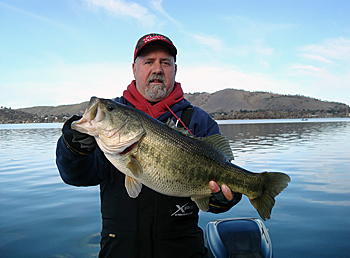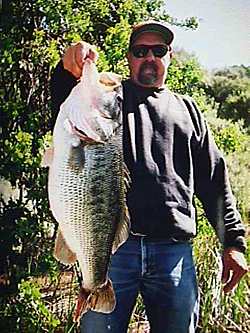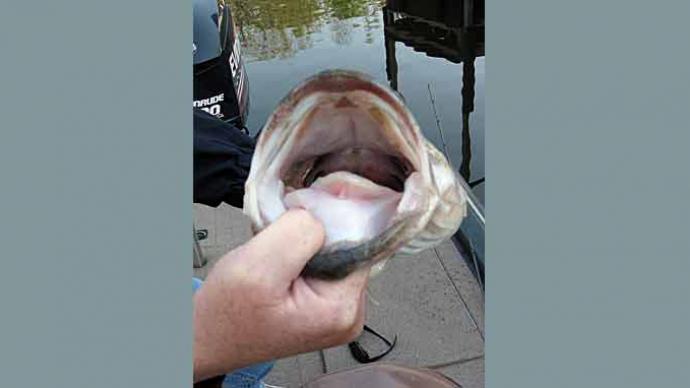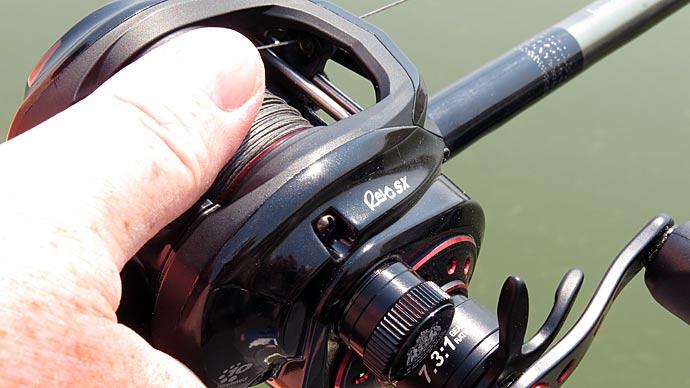
Don Osborne is a big swimbait expert. He has used them to catch 130 bass weighing more than 10 pounds, including five that tip the scales beyond 15 pounds. But getting to that point involved an ironic twist.
Osborne enjoyed trout fishing and finished second in a local derby with an 8-pounder. “The prize for that was a guided trip with Paul Duclos,” he said. The noted big-bass specialist, who released a bass that weighed 24 pounds on an uncertified scale, opened Osborne’s eyes to the potential of big swimbaits. “He showed me what was in my lake that I had no idea was there,” he said. That was almost 20 years ago. Since he caught his first double-digit weight bass, he hasn’t fished for trout. Instead, he feeds imitation ones to giant bass.
The northern California lakes near Osborne’s home are filled with a special kind of bass, the result of crossing Florida and Northern strains. “They get really long and really fat,” he said. While genetics ensures that happens, the trout they eat make it so by passing along the benefits from their nutrient-rich hatchery feed.
Photos and stories of big bass caught on swimbaits 7 inches, and longer abound, enticing bass anglers everywhere to try them. But if your tackle box is filled with typical-sized bass lures, attaching something the size of a tennis shoe that weighs a quarter-pound or more can give reason to pause. But don’t let it. With a bit of dedication and an outside-the-box approach, you can use swimbaits to catch the biggest bass in your home lake. “And when you do, you’ll be hooked like everyone else who catches a big bass,” Osborne said.
They were considered a regional technique when big swimbaits first arrived on the bass-fishing scene. Sure they caught giants, but only in California. That perception is changing, thanks partly to Western bass tournament pros fishing them to high finishes in the East and weekend anglers embracing their potential. Big swimbaits catch bass from California to Virginia and Texas to New England. At lakes across the South, Osborne said tournaments are won with five-bass limits consisting of one giant bass caught on a big swimbait and four regular-sized ones. “There’s big bass in every lake,” he said. “You just have to fish for them.”
Fishing big swimbaits requires work. “It’s very mentally challenging,” Osborne said. “You have to leave the drop shot at home. You must get skunked 10 or 20 days in a row and learn how to fish these baits.” The bass big enough to eat them didn’t get that way by accident. He believes they have been caught before, making them wary feeders. But that doesn’t mean they’re uncatchable.
What gear to get
Even your stoutest flipping stick is no match for big swimbaits. The backbone of Osborne’s setup is an 8-foot rod made by Conway Custom or Dobyns. It handles swimbaits up to 8 ounces. Its fast-action tip gives him better control and feel of his swimbait. Its firm backbone drives home the hooks and moves the bass toward him on the set. He locks the drag on his Shimao Calcutta 400 reel, which handles 160 yards of 20-pound test monofilament and sports a 5:1 gear ratio. “[The bass is] coming to me,” he said.
Osborne’s line receives the most attention. “If you use cheap line, there’s no reason having the rest,” he said. He routinely rubs a cotton swab around the inside of every line guide on each of his rods. Cotton will snag on grooves, chips, or cracks. Any of those could nick his line, causing it to break. He removes the imperfections by sanding them with an emery cloth.
Osborne spools his reel with 25-pound test Maxima Ultragreen monofilament. He uses a Palomar knot to attach a 65-pound test clip, which makes changing lures easy. He regularly checks the 10 feet of line closest to his swimbait, feeling for nicks, abrasions, and other weak spots. That’s where it’s most likely to break.
Which swimbaits to buy
A decade ago, Ken Huddleston, who helped create Castaic Swimbaits in the mid-1990s and now sells his own, shared an observation with Osborne. There wasn’t an online store that specialized in swimbaits and the gear to fish them. So Osborne opened swimbaitcity.com. Its Instagram account highlights new products, lure availability, and recent catches. But choices are often to the detriment of beginners. They need a few big swimbaits that regularly produce bites, so their time is spent building confidence, not changing lures.
Osborne suggests starting with three styles of big swimbaits: a soft-plastic swimming trout imitator, wake bait, and topwater. While multiple manufacturers make each style, he’s grown close to these.
The trout-shaped and -colored 8-inch Huddleston Deluxe is one of the best-known big swimbaits. It has won West Coast tournaments and landed personal bests for many anglers, including Osborne. His weighed 17.5 pounds. All his bass, 15 pounds and heavier, were caught on that lure. “That’s why I don’t leave home without it,” he said. He likened its big-bass powers to the Heddon Zara Spook, the walking topwater introduced more than 75 years ago. He said they’ve been catching big bass for a long time and will continue for many years. Huddlestons are categorized by the rate of fall — how many feet the lure sinks on slack line every 10 seconds. He uses the 0, 5, and 12.
Osborne chooses an M.S. Slammer when he wants a big swimbait that he can present closer to the surface. The joined wake bait has a soft-plastic boot tail. Mike Shaw has hand-built them since 1993, and they are offered in three sizes: 7, 9, and 12 inches.
Osborne’s choice for topwater is the Lunker Punker from Black Dog, which comes in 8-inch size. He said the walking lure draws explosive strikes, some pushing it 4 feet into the air.
While Osborne is particular about which swimbaits he throws, he’s not sold on the importance of their color. He lets Bassmaster Elite Series angler Steve Kennedy prove his point. The amicable Alabama angler won the 2007 Bassmaster Elite Series event at California’s Clear Lake, the natural body of water where big bass love big swimbaits. He caught 122 pounds and 17 ounces — an average of slightly more than 6 pounds per bass. That set the series’ four-day record for five-bass limits until veteran Mississippi pro Paul Elias caught 132 pounds and 8 ounces from Lake Falcon in Texas the following season.
Kennedy fished a jig for a 20-pound limit on Day 1, but his catches the next three days caught the bass fishing world’s attention. His biggest — 40 pounds and 7 ounces — came on Day 3. Those giants fell to 8-inch Huddlestons in a rainbow trout pattern, some of the $3,000 of swimbaits he purchased during that season’s West Coast swing. But there’s one crucial footnote, Osborne said. Clear Lake doesn’t have rainbow trout.
Swimbaits have a characteristic that’s more important than color. “It’s the action of the lure,” Osborne said. The life-like seductive S-curves that they make are what attract bass. He said to find a swimbait whose action triggers strikes from the bass you’re targeting and select a color that closely matches the forage they’re eating. On the Savannah River lakes along the Georgia-South Carolina line, for example, it would be a pattern that resembles the bright sides and dark back of blueback herring.
How to present them

Osborne often leaves his boat at home when fishing big swimbaits. Sneaking along the shoreline, he uses trees and vegetation to disguise his presence from wary big bass. He caught most of his bass over 10 pounds from the bank. But regardless if he’s on shore or on a boat, he uses these approaches.
You have to find a big bass first. When the water is clear, Osborne checks prime ambush spots, such as a large rock or piece of brush on a creek channel point, by slowly reeling his big swimbait over them. “They are curious creatures,” he said. “They are going to check it out.” Nine out of 10 bass never eat his lure, but that’s OK. “Now I know it’s there,” he said. He’ll leave and wait about an hour before returning. That allows the bass to reposition.
A slower version of this approach catches more bass. Osborne lets his big swimbait sink to the bottom, then slowly rolls it, adding frequent pauses. Keeping the lure moving along the bottom and across the cover, such as brush, docks, or rocks, is essential. You’ll lose swimbaits doing this, but he said the giant bass it produces justifies the sacrifice.
Osborne inches his big swimbait across a spot in a technique he calls dead sticking. The key is minutes-long pauses between each barely visible forward movement. He lets the lure sit motionless after it splashes down. He feels giant bass are conditioned to hearing a splash and then seeing a lure whizz by. He said that adding time between splashdown and the retrieve causes bass to disconnect the two events, making them more willing to strike.
While Osborne also trolls swimbaits, his favorite presentation is the bump and run. He’ll let his Huddleston fall to the bottom and rest. Then he moves it with a set of three short hops no more than 1-foot long, waiting no less than 2 minutes before repeating. One 30-yard cast might last five minutes. “If you think you are fishing it slowly, fish it slower,” he said.
When to fish swimbaits
Osborne seeks certain conditions that put the odds of catching a big bass more in his favor. “There’s no season for swimbaits,” he said. “But there are better times.”
Osborne is one of the few Americans who know precisely when it’s time to change the clocks, either forward in spring or back in fall. Those activities coincide with the best times for catching giant bass on big swimbaits. He said that Bass are after big meals in the fall in preparation for winter, and they do the same in spring to prepare for the spawn.
The spring bite, he said, happens best near hard cover such as rocks and concrete. Those materials used around launch ramps and bridge pilings are warmed by the sun. They release that heat into the water, which jumpstarts cold-blooded bass.
Osborne keeps an eye on the barometric pressure, expecting better fishing when it drops. He also watches the lunar calendar, planning trips on the days around a full or new moon. When the moon is full on a clear night, he fishes his best spots when it’s starting to set or ready to rise.
BassResource may receive a portion of revenues if you make a purchase using a link above.




